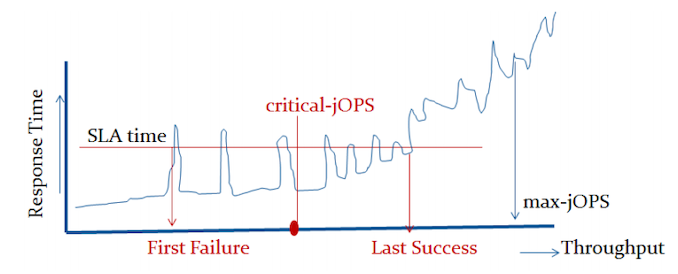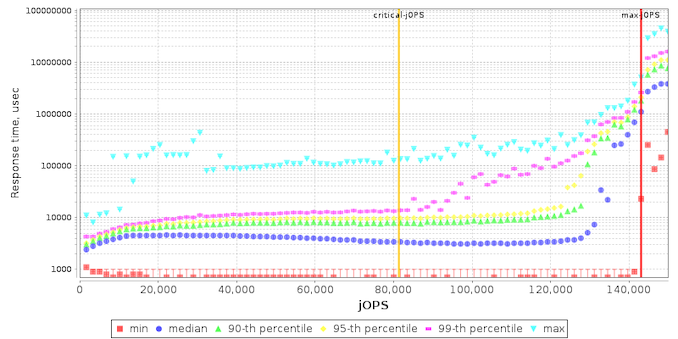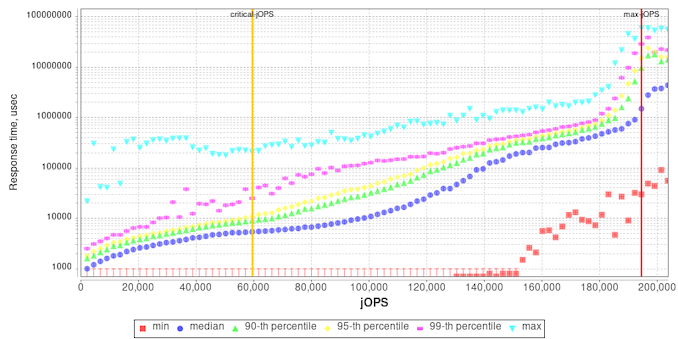The Ampere Altra Review: 2x 80 Cores Arm Server Performance Monster
by Andrei Frumusanu on December 18, 2020 6:00 AM EST- Posted in
- Servers
- Neoverse N1
- Ampere
- Altra
SPECjbb MultiJVM - Java Performance
Moving on from SPECCPU, we shift over to SPECjbb2015. SPECjbb is a from ground-up developed benchmark that aims to cover both Java performance and server-like workloads, from the SPEC website:
“The SPECjbb2015 benchmark is based on the usage model of a worldwide supermarket company with an IT infrastructure that handles a mix of point-of-sale requests, online purchases, and data-mining operations. It exercises Java 7 and higher features, using the latest data formats (XML), communication using compression, and secure messaging.
Performance metrics are provided for both pure throughput and critical throughput under service-level agreements (SLAs), with response times ranging from 10 to 100 milliseconds.”
The important thing to note here is that the workload is of a transactional nature that mostly works on the data-plane, between different Java virtual machines, and thus threads.
We’re using the MultiJVM test method where as all the benchmark components, meaning controller, server and client virtual machines are running on the same physical machine.
The JVM runtime we’re using is OpenJDK 15 on both x86 and Arm platforms, although not exactly the same sub-version, but closest we could get:
Altra system:
openjdk 15.0.1 2020-10-20
OpenJDK Runtime Environment 20.9 (build 15.0.1+9)
OpenJDK 64-Bit Server VM 20.9 (build 15.0.1+9, mixed mode, sharing)
EPYC & Xeon systems:
openjdk 15 2020-09-15
OpenJDK Runtime Environment (build 15+36-Ubuntu-1)
OpenJDK 64-Bit Server VM (build 15+36-Ubuntu-1, mixed mode, sharing)
Furthermore, we’re configuring SPECjbb’s runtime settings with the following configurables:
SPEC_OPTS_C="-Dspecjbb.group.count=$GROUP_COUNT -Dspecjbb.txi.pergroup.count=$TI_JVM_COUNT -Dspecjbb.forkjoin.workers=N -Dspecjbb.forkjoin.workers.Tier1=N -Dspecjbb.forkjoin.workers.Tier2=1 -Dspecjbb.forkjoin.workers.Tier3=16"
Where N=160 for 2S Altra test runs, N=80 for 1S Altra test runs, N=112 for 2S Xeon, N=56 for 1S Xeon, and N=128 for 2S and 1S on the EPYC system. I tried running 256 or 160 threads on the 2S EPYC configuration but the benchmark would error out with a critical timeout and I wasn’t able to fully debug as to why it did that.
In terms of JVM options, we’re limiting ourselves to bare-bone options to keep things simple and straightforward:
Altra & EPYC system:
JAVA_OPTS_C="-server -Xms2g -Xmx2g -Xmn1536m"
JAVA_OPTS_TI="-server -Xms2g -Xmx2g -Xmn1536m"
JAVA_OPTS_BE="-server -Xms48g -Xmx48g -Xmn42g -XX:+AlwaysPreTouch"
Xeon system:
JAVA_OPTS_C="-server -Xms2g -Xmx2g -Xmn1536m"
JAVA_OPTS_TI="-server -Xms2g -Xmx2g -Xmn1536m"
JAVA_OPTS_BE="-server -Xms172g -Xmx172g -Xmn156g -XX:+AlwaysPreTouch"
The reason the Xeon system is running a larger back-end heap is because we’re running a single NUMA node per socket, while for the Altra and EPYC we’re running four NUMA nodes per socket for maximised throughput, meaning for the 2S figures we have 8 backends running for the Altra and EPYC and 2 for the Xeon, and naturally half of those numbers for the 1S benchmarks. The back-ends and transaction injectors are affinitised to their local NUMA node with numactl –cpunodebind and –membind, while the controller is called with –interleave=all.
The max-jOPS and critical-jOPS result figures are defined as follows:
"The max-jOPS is the last successful injection rate before the first failing injection rate where the reattempt also fails. For example, if during the RT-curve phase the injection rate of 80000 passes, but the next injection rate of 90000 fails on two successive attempts, then the max-jOPS would be 80000."
"The overall critical-jOPS is computed by taking the geomean of the individual critical-jOPS computed at these five SLA points, namely:
• Critical-jOPSoverall = Geo-mean of (critical-jOPS@ 10ms, 25ms, 50ms, 75ms and 100ms response time SLAs)
During the RT curve building phase the Transaction Injector measures the 99th percentile response times at each step level for all the requests (see section 9) that are considered in the metrics computations. It then computes the Critical-jOPS for each of the above five SLA points using the following formula:
(first * nOver + last * nUnder) / (nOver + nUnder) "

That’s a lot of technicalities to explain an admittedly complex benchmark, but the gist of it is that max-jOPS represents the maximum transaction throughput of a system until further requests fail, and critical-jOPS is an aggregate geomean transaction throughput within several levels of guaranteed response times, essentially different levels of quality of service.
Beyond the result figures, the benchmark keeps detailed track of timings of responses and tracks a few important statistical data-points across a response-time curve, as follows:
I’m starting off with the EPYC results as they’re sort of standard – the max-jOPS here ends up quite high at over 270k, while the critical-jOPS ends up around 125k. The system still manages to retain 90th percentile response times under 20ms up until 230k which is excellent, with 99th percentile results starting to degrade after 110k jOPS.
On the Xeon system, we see similar flat 90th percentile response times up until around 120k with 99th percentiles starting to degrade following 90k, but in a much tighter curve than on the EPYC system – while the system here has less overall throughput its scaling up to that throughput limit could be considered to be better.
With the EPYC and Xeon systems as context, we’re finally looking at the Altra results, which look very different.
Unlike the x86 systems, 99th and 90th percentile response times degrade earlier on in the throughput curve for the Altra chip. What this actually reminded me of is the STREAM results from earlier in the review where we saw that initially a bunch of cores were able to hit peak bandwidth across the memory controllers, but adding further cores to the mix actually degraded performance, pointing out to suboptimal congestion across the mesh interconnect.
It might be possible that the results here across SPECjbb are hitting a similar level of saturation under load, given that there’s a lot of inter-core communication and memory transactions happening.

Charting the max-jOPS of the different systems, I ran figures for both 1S and 2S system configurations. Additionally, I also tested out the benchmark both with transparent huge pages always enabled, and to a default not used / madvise state, as we’ve seen in the past that this can have a notable impact on the resulting performance.
Whilst the Altra system is able to beat the Xeon, it’s not sufficient to match the EPYC system which still lies considerably ahead by a good margin. The exact reasons for this discrepancy compared to the x86 systems isn’t immediately clear, as we’re dealing with many layers here. AArch64 OpenJDK JVM performance certainly might not be as mature and optimised as the x86-64 counterparts, and there is certainly a rabbit hole of various optimisations and knobs we could have tried to change things – although we still view these simple default out-of-the-box settings to still be valuable and valid in terms of comparisons.
One thing that did come to mind immediately when I saw the results was SMT. Due to this being a transactional data-plane resident type of workload, SMT will undoubtedly help a lot in terms of performance, so I tested out the EPYC chip figures with SMT disabled, and indeed max-jOPS went down to 209.5k for the 2S THP enabled results, meaning that SMT accounts for a 29.7% performance benefit in this benchmark.
A further indication that the Altra system is being underutilised on the part of the cores and memory-bottlenecked is its power consumption, which even when fully loaded in the RT curve, it generally hovered around 170-180W per socket, while the x86 systems were filling up their TDPs.
It’s generally these kinds of workloads that SMT works best on, and that’s why IBM can deploy SMT4 or SMT8 processors, and the type of workloads Marvell’s ThunderX was trying to carve a niche or itself with SMT4.

For the critical-jOPS figures, the Altra doesn’t do well at all given its response-time curve. Beyond the lack of SMT (The EPYC here again achieves its high score through a 26.4% contribution of the secondary logical cores), we’re maybe looking at a software side immaturity of out-of-the-box Java performance on Arm systems. The figures here shouldn’t be taken with absolute authority with a conclusion that Java performance on the Altra sucks, but at least we’re seeing signs that it doesn’t look too great.













148 Comments
View All Comments
Brane2 - Saturday, December 19, 2020 - link
Meh. Nothing special. it has been benchmarked on Phoronix and it performed more or less on par with Rome. 80 newest ARM cores against 64 mature x86 cores within constrained power envelope.Naples is just about to come out and I suspect some time after that AMD will have something like really wide new RISC-V cores.
Wilco1 - Saturday, December 19, 2020 - link
It won most benchmarks on Phoronix while using significantly less power. Yes Milan is about to be released, and it will have to compete with the 128-core Altra Max. Which do you believe is going to win - 64 SMT cores or 128 real cores?mode_13h - Sunday, December 20, 2020 - link
It actually won less than half of the benchmarks on phoronix, since a number of those graphs just re-state the results in score/W. There are also questions over some of the compiler options used on those benchmarks, since many of the tests are compiled with options that won't enable AVX on benchmarks where it should be beneficial (yet, not having SVE, the N1 cores are at no such disadvantage).Wilco1 - Monday, December 21, 2020 - link
"should be beneficial" -> "might help in a few limited cases". AVX/AVX512 isn't that useful for general C/C++ code. You typically only see large gains when people optimize using intrinsics.mode_13h - Monday, December 21, 2020 - link
Intrinsics don't compile if they're for a CPU arch beyond what the compiler is being instructed to target. So, even packages where people take the time to optimize with intrinsics need to guard them with compile-time checks to ensure the CPU target is capable of executing those instructions.Compilers do generate vectorized code. I don't know how well GCC is doing on that front, lately, but the TNN tests should be a good way to see that. Too bad those tests don't use -march=native.
What's interesting about TNN is I'm looking at the exact source revision Phoronix is using, and it seems they've completely dropped their backend for x86. The source/tnn/device/x86/ is simply missing. So, I wonder if they decided the compiler was good enough that they didn't need to bother with their own hand-optimized code for it, or if they just decided they don't care how fast their stuff runs on it.
See:
* https://openbenchmarking.org/innhold/83a730ed41d4e...
* https://github.com/Tencent/TNN/tree/v0.2.3
Wilco1 - Monday, December 21, 2020 - link
TNN does not benefit from -march=native. Phoronix uses the generic C++ version which doesn't benefit from vectorization. Try it yourself.Optimized versions using intrinsics typically use runtime checks so you automatically get the fastest version that works on your CPU. The makefile selects the right ISA variant for any files using intrinsics. But none of this is used in the TNN test.
mode_13h - Monday, December 21, 2020 - link
> TNN does not benefit from -march=native. Phoronix uses the generic C++ version which doesn't benefit from vectorization. Try it yourself.At this point, I probably will.
> Optimized versions using intrinsics typically use runtime checks so you automatically get the fastest version that works on your CPU.
That's a whole additional level of effort for the developers. For them to bother compiling and conditionally calling different versions only makes sense if they think their main userbase aren't going to bother recompiling specifically for their hardware. In the case of specialized packages, it's reasonable to expect your users to take a little trouble for the best performance. It's really things like very low-level libs or multimedia code where you tend to see the sort of elaborate runtime detection and dynamic codepath selection that you're describing.
mode_13h - Monday, December 21, 2020 - link
I think Basis Universal and High Performance Conjugate Gradient are some other cases where the wider SIMD of Zen2 and Skylake-SP should confer significant benefit.Wilco1 - Monday, December 21, 2020 - link
"should give significant benefit" -> "might give some benefit". I suggest you try out. Autovectorization is not nearly as good as you seem to believe, and the overall speedup is often disappointing even if some loops are 10-20x faster.vinayshivakumar - Saturday, December 19, 2020 - link
I am a bit puzzled why none of these processors support SMT... Can someone shed light on why this is the case ?